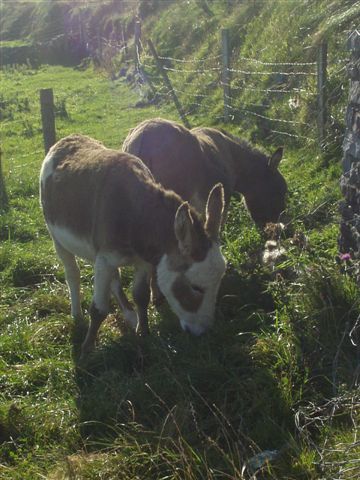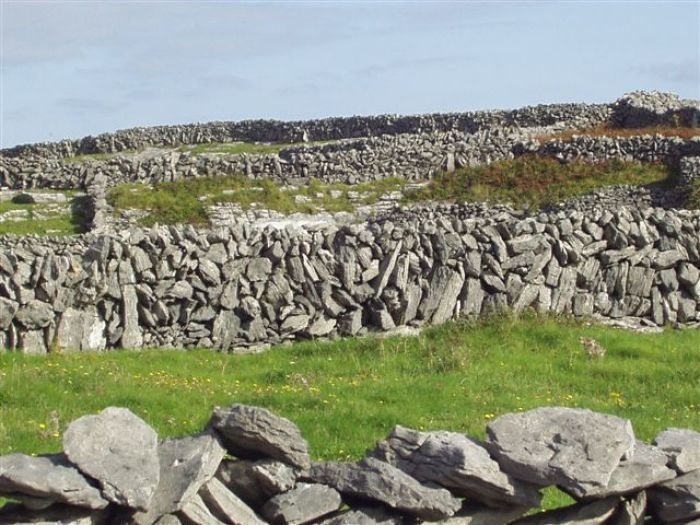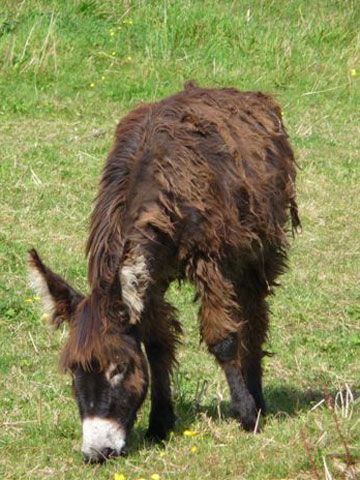
No wonder Ireland is called the Emerald Isle: it is unbelievably verdant green. One cannot begin to imagine the many shades of green that there are until they go to Ireland and actually see them—endless rolling hills of green—lush fertile countryside appearing as continuous patchwork quilts of textured greenery. It is truly like an unfolding storybook for a gardener or nature lover. When taking photos of this land, I found that one could not capture the true beauty and essence on film. Every turn in the road, elicited yet another ooh or aah or a similar exclamation. (My driving on the left side of very narrow roads with hedgerows, rock walls, and oncoming traffic of large vehicles such as tour buses and farm machinery also educed numerous exclamations, however they were often louder and not of an admiring nature!) My sister Donny, who was the chief “nagivator” riding shotgun, claimed daily that she was eating shrubbery or picking it from her teeth and loudly told me to “Mind the shrubbery; mind the wall; mind the pedestrian; mind the curb; mind the car; mind the cliff ”, etc. whenever she felt it necessary to do so.
| Much of the Irish landscape is a patchwork of green fields. | |
| Fuchsia is a common roadside plant. | |
One thing we looked for and used often were the “lay-bys” which is what the Irish call a pull-off or view point; they were often dirt or rock with potholes and only big enough for one car; however we put them to good use. We used these to photograph vistas, from ocean to farmland, sheer rock cliffs, rolling hills and fields of sheep, cattle, horses, donkeys, sheep in the road, seals on rocks, thatched roof cottages and more.
Keeping in mind, that Ireland is an island surrounded by water; ocean, bay, and sound views were often in the distance of the green pastoral scenes, only making them more breathtaking. Since the country receives an enormous amount of rainfall per anuum, we were fortunate to experience this type of wet weather only once or twice. This precipitation is what makes the peat bogs wet and the hedgerows so huge. The latter sometimes grow to 12 feet or so in height and line the roads, sometimes there are stone walls behind them, sometimes not; it is hard to tell since they are so thick. They might have some ivy in them, there are vast numbers of blackberries and raspberries, some brambles, honeysuckle, viburnum, morning glories and unbelievably huge fuschias everywhere. I was a bit surprised to find so many of the same or similar plants that we have on our east coast in the USA.
Fields were full of grasses for grazing cattle, horses, donkeys and sheep. The native weeds were plantain, yarrow, self heal (Prunella), sheep’s sorrel, clover, dandelion—just like in my backyard in Maryland. There was some corn growing (for livestock, not human consumption), lots of hay, and grains like wheat and oats, most especially barley.
 |
Peat bogs
 |
|
In some low-lying areas where it looked like fields of grass or dark soil, there were peat bogs. If you got out and walked, you might sink down and get your feet wet. In drier areas, peat was in evidence by strange rows of freshly dug earth; they use long, narrow shovels to dig the peat and it makes a log shape. Then they stack the peat logs in conical mounds to dry and once they are dried hard they load them into wagons.
Peat is cut from the bogs, then stacked and left to dry. then loaded into wagons. |
| Laundry dries over a peat fire. |
In the past, these peat logs were burned like firewood. Nowadays, the peat is processed so it is cleaner and burns better. We had the pleasure of a woodstove in one of the cottages we stayed in, and I built a peat fire every night we were there. It had a lovely peaty smell, and we hung our laundry over the stove on a specially designed rack, which had a pulley and a rope to pull it up so it dried quickly as the heat rose. I still have some clothing with the smell.
What isn’t green is very rocky
As green and luxuriant as this country is, its opposite component is rock, mostly limestone. Unbelievable rock. Rock like I have never seen anywhere—in many places there was rock for as far as the eye can see. In order to grow crops, the Irish people have cleared the land for thousands of years. There is so much rock, that it has been piled into walls that sometimes mark land boundaries, however mostly it has been placed haphazardly as it was lifted and stacked, so there are stone walls after stone walls, running parallel, diagonally, and perpendicular across the landscape.
I found this much rock astounding to behold. Out on the island of Inishmore (one of the Aran Islands off the western coast), as we sat in awe staring at these endless piles of rock, our local driver (and quite the Irish character), Thomas O’Toole told us that there are two things that the Irish do well: “Grow rocks and drink Guiness”. Which I would have to agree with wholeheartedly.
The Burren
| The Burren. |
One of the rockiest places is called the Burren and it will be the subject of my next post. Although it is mainly rock, there is an amazing amount of flora found there and it is totally intriguing. So check out the next installment for more rocks and plants and photos of it all!



































Comments
Log in or create an account to post a comment.
Sign up Log in